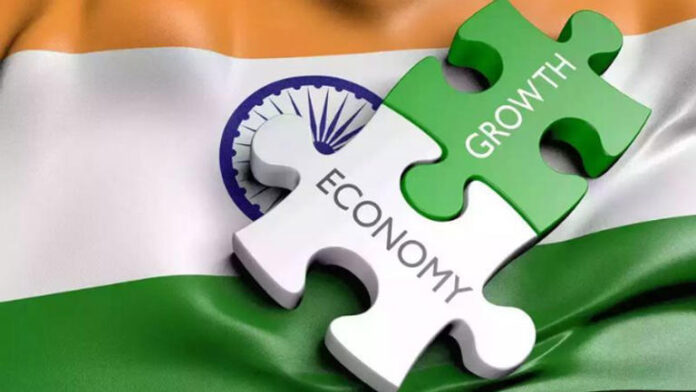
In 2025, Tamil Nadu’s Gross State Domestic Product (GSDP) surpassed Pakistan’s National Gross Domestic Product (GDP).
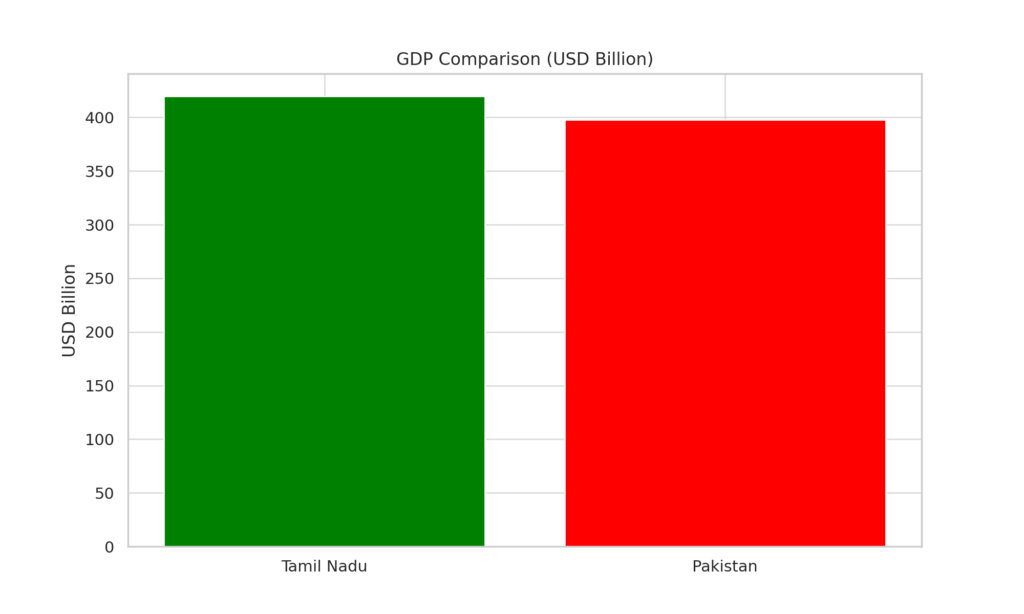
In 2025, Tamil Nadu would see the realization of its highest GSDP, surpassing that of the national GDP of Pakistan. Tamil Nadu stood at $419.74 billion in GSDP, while Pakistan was at an estimated $397.58 billion in GDP. This indeed is a true reflection of the southern state achieving strong economic growth contributions toward India’s recognition as one of the leading economic countries across the globe. The article discusses how Tamil Nadu successfully advanced economically, compares its features with those of Pakistan’s economy, and reflects on how such an achievement relates to India’s federal structure.
Tamil Nadu: A Glimpse of Economic Powerhouse
Holding a mere 4% of the total geography of India and having only 6% of the population, Tamil Nadu has emerged as a state in manufacturing and services, which in the year 2025 contributed to the national GDP of India by as much as 9.37%. The GSDP galloped in the state in 2025 to ₹35.67 lakh crore (around $419.74 billion), indicating its phenomenal real growth rate of 9.69% in the fiscal year 2024–25—the highest among all the Indian states. This rate goes beyond India’s national real GDP growth of 6.48%, while Pakistan’s GDP is projected with a growth rate of 3% for this period.
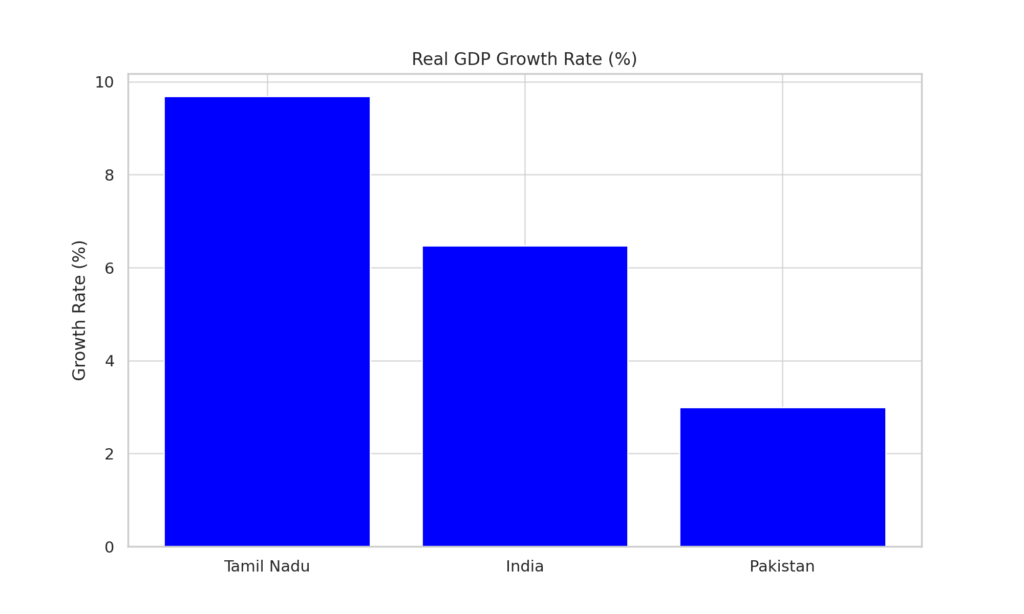
The economy’s substantive resilience is supported by diversification, wherein 53% of the Gross State Value Added (GSVA) accounted for services, industry contributed 37%, and agriculture constituted 10%. The top drivers for Tamil Nadu include automobile production, textiles, leather exports, IT services, progressive policies, and infrastructure development. This is almost double the Indian average of ₹1.96 lakh ($2,300), much ahead of Pakistan’s per capita GDP of around $1,500.
Pakistan’s Economic Tangle: A Contrast
An economy that stands 43rd in the world refers to nominal GDP and, therefore, has manifold challenges such as political instability, dependence on foreign aid, and an IMF-projected downgrade of GDP growth to 3% for the year 2025. Pakistan’s GDP of $397.58 billion comparatively depicts a sluggish momentum relative to an over-three-times population of 254.4 million, compared to that of Tamil Nadu, which is 80 million. An economy is basically an agriculture-dependent economy (24% of GDP) and textiles; it has few diversification and industrialization benefits as compared with those of Tamil Nadu.
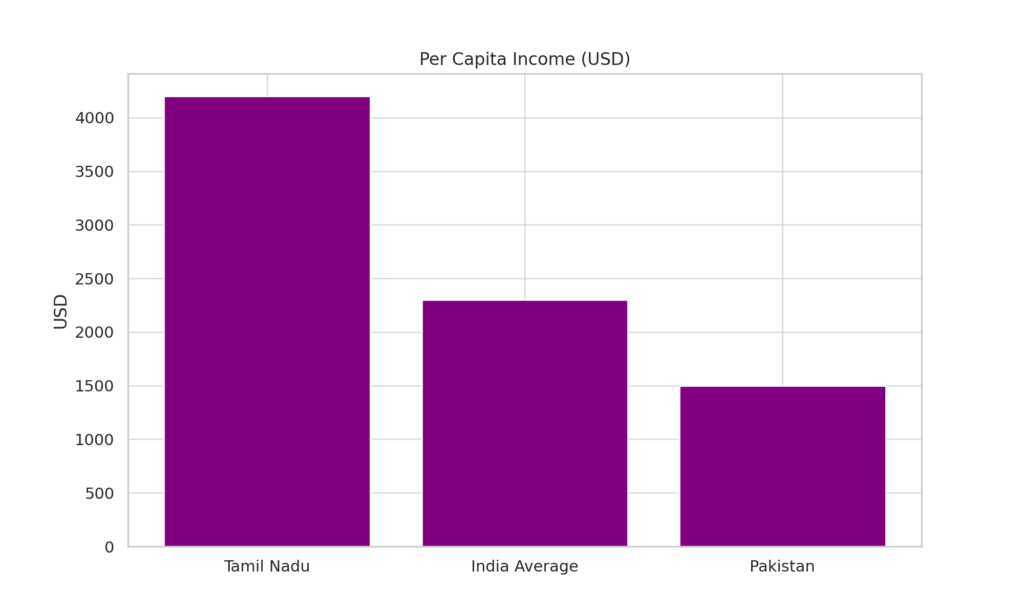
Inflationary scares (which beat at 9.5% in 2025) from external debt and a climate of little foreign direct investment (FDI) add to Pakistan’s already tarnished complexion. Tamil Nadu holds the inverse scenario. In the past, it has attracted enormous amounts from outside, thereby boosting industrialization. Tamil Nadu holds 12.11% of India’s industrial GDP. The apparent suspension of the trade agreements like the Indus withholds the already dim outlook of Pakistan, while the political setup in Tamil Nadu leverages India’s macroeconomic stability and global trade.
Comparative Analysis: Tamil Nadu vs. Pakistan
To understand how grave Tamil Nadu’s achievement is, key economic indicators of 2025 will now be compared:
| Indicator | Tamil Nadu | Pakistan |
| GDP/GSDP (USD Billion) | $419.74 | $397.58 |
| Real Growth Rate | 9.69% | 3% |
| Per Capita Income (USD) | $4,200 | $1,500 |
| Population (Million) | 80 | 254.4 |
| Contribution to National GDP | 9.37% (India) | N/A |
| Key Sectors | Services (53%), Industry (37%) | Agriculture (24%), Industry (19%) |
The table shows Tamil Nadu having more potential and growth than Pakistan in every parameter. The state achieves greater economic output with dwindling population figures. Thus, the state focuses on high-value sectors such as IT, automotive, and manufacturing, whereas Pakistan remains entrenched in low-productivity agriculture.
Tamil Nadu has shown phenomenal growth in its economy.
- Industrial and services supremacy: Industrially, Tamil Nadu has been characterized by extensive production facilities in the automotive and electronics manufacturing sectors. Such investments in special economic zones (SEZs) benefit from the availability of a skilled workforce. The performance of the services industry in professional towers such as those centered in Chennai and Coimbatore brings 13.6 percent growth in professional services and 13 percent for communications.
- Policy reforms and infrastructure: Growth is attributed to economic policies like Kalaignar Mahalir Urimai Thittam (₹1,000 monthly for female heads of households) and free electricity for domestic consumers, as described by the Economic Survey 2024–25. This progressive consumption creates conducive conditions for stabilizing inflation. Furthermore, infrastructure projects such as highways and renewable energy will promote minimal connectivity and sustainability.
- Education and Skill Development: It has higher education gross enrolment ratios of 47%, as compared to the 28.4% of India as a whole. The investment into universal primary education since the 1980s has given a skilled workforce developed sufficiently well that perhaps even the global companies like Tata and Foxconn would come here to employ their workforce.
- Export-led growth: Being the premier state in India in textiles, leather, and automobile exports, Tamil Nadu is a leading contributor to the exchange earnings of the entire country. The state has directed its efforts to “Made-in-India” initiatives to further enhance its global competitiveness.
With its success, however, Tamil Nadu is facing a threat to growth: the reliance of its economy on global markets makes trade disruption a potential risk. The state has also been borrowing, with a fiscal deficit reaching ₹1,06,963 crore (3% of GSDP) in 2025–26, putting it under considerable debt pressure. Environmental issues, including water scarcity and climatic vulnerabilities, add risk to this picture. The opposition has criticized the government in this regard, demanding a more cautious stance for the economy.

Implications for India and Beyond
Tamil Nadu’s surpassing GDP compared to that of Pakistan is a state achievement, although it is the federal economic might of India that can be termed as the reason behind it. Maharashtra would make a GSDP of $500 billion, while Tamil Nadu would reach $419.74 billion, indicating that individual Indian states are now outperforming entire nations—it heralds India’s decentralized model of growth. This landmark achievement may encourage more states to follow in the footsteps of Tamil Nadu and thus invigorate competitive federalism.
For Pakistan, this indicates a dire need for structural reforms toward industrialization and reduced dependence on aid. The gap in economies between India and Pakistan is vastly growing, with India boasting a GDP of $4 trillion, 10 times that of Pakistan. This divide is growing due to states like Tamil Nadu.
Future Expectations: A Trillion-Dollar Economy?
Experts suggest that Tamil Nadu could become a trillion-dollar economy by 2032 at its current growth rate of 9.7%, assuming improvements in sectoral growth by 0.5 percentage points per year. For 2025–26, the state budget estimates a nominal growth of GSDP at 14.5 percent, with a real growth rate of 9 percent and 5.5 percent inflation. This further prospect can be enhanced by investments in renewable energy, AI, and green manufacturing.
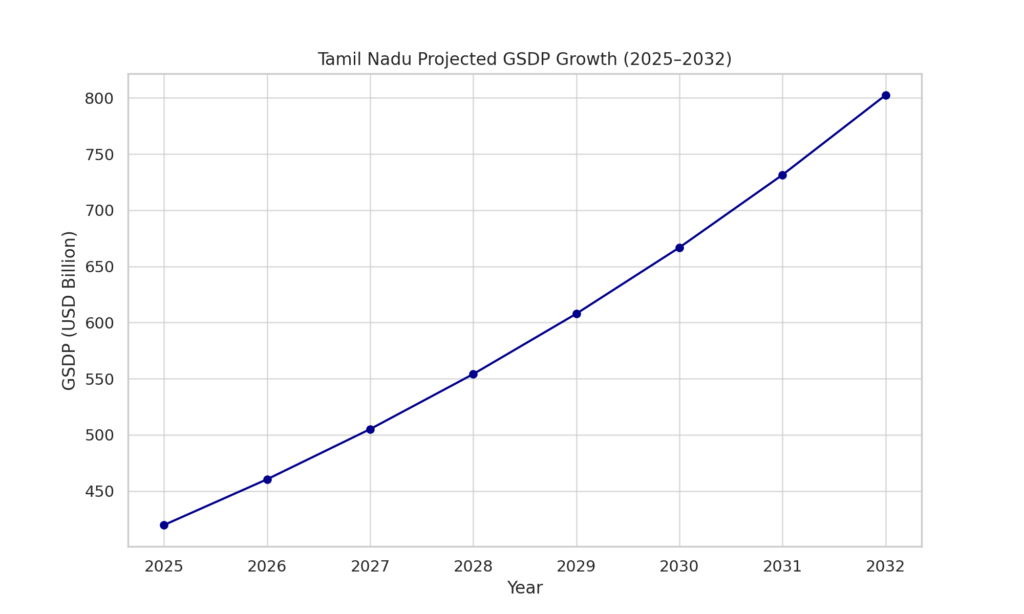
Conclusion
In 2025, it will outpace the GDP of Pakistan as a country, making it a milepost in the growth story of India. The state has set an example through industrialization, policy innovation, and a skilled workforce for economic excellence. While the threats of debt and environmental risks loom, they are conditions that Tamil Nadu manages to contend with strategically. This will elevate the state’s stature and thus contribute to India’s emergence as a federation of economic powerhouses.






